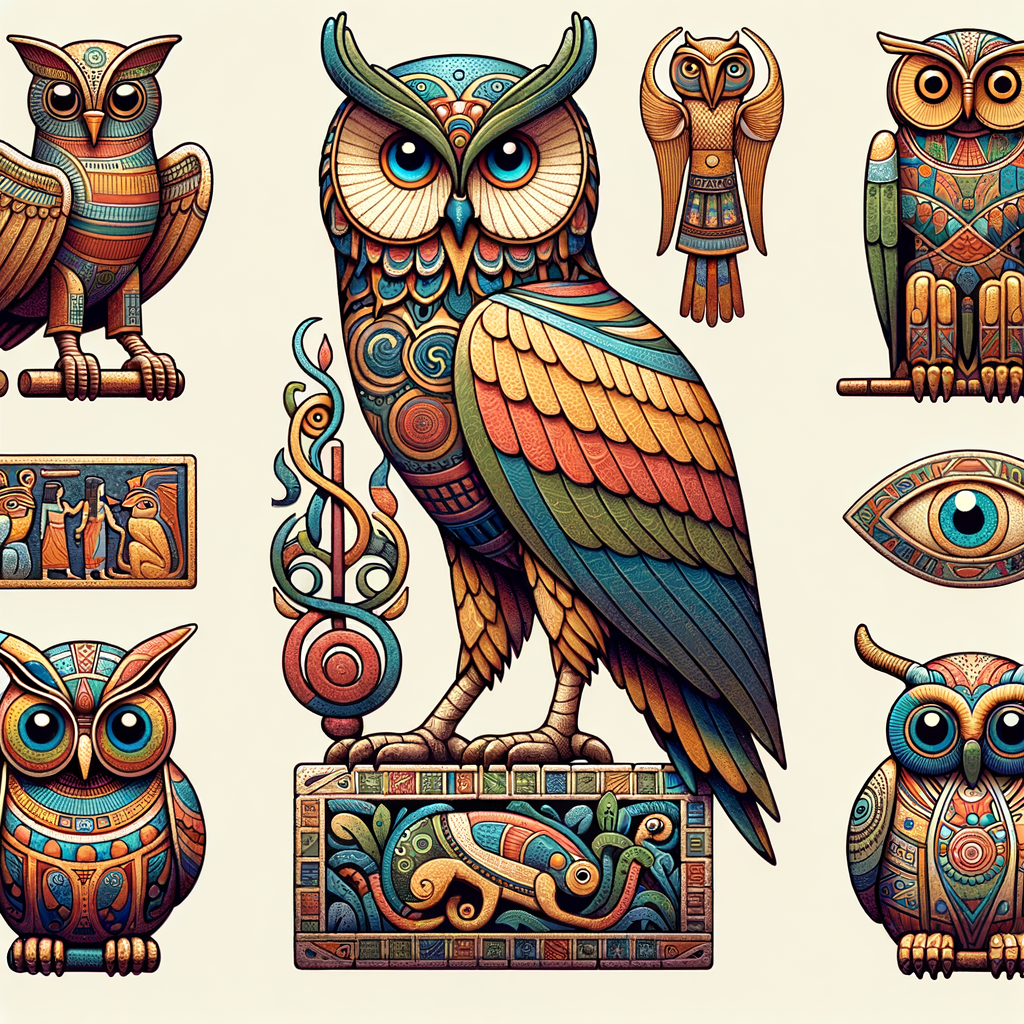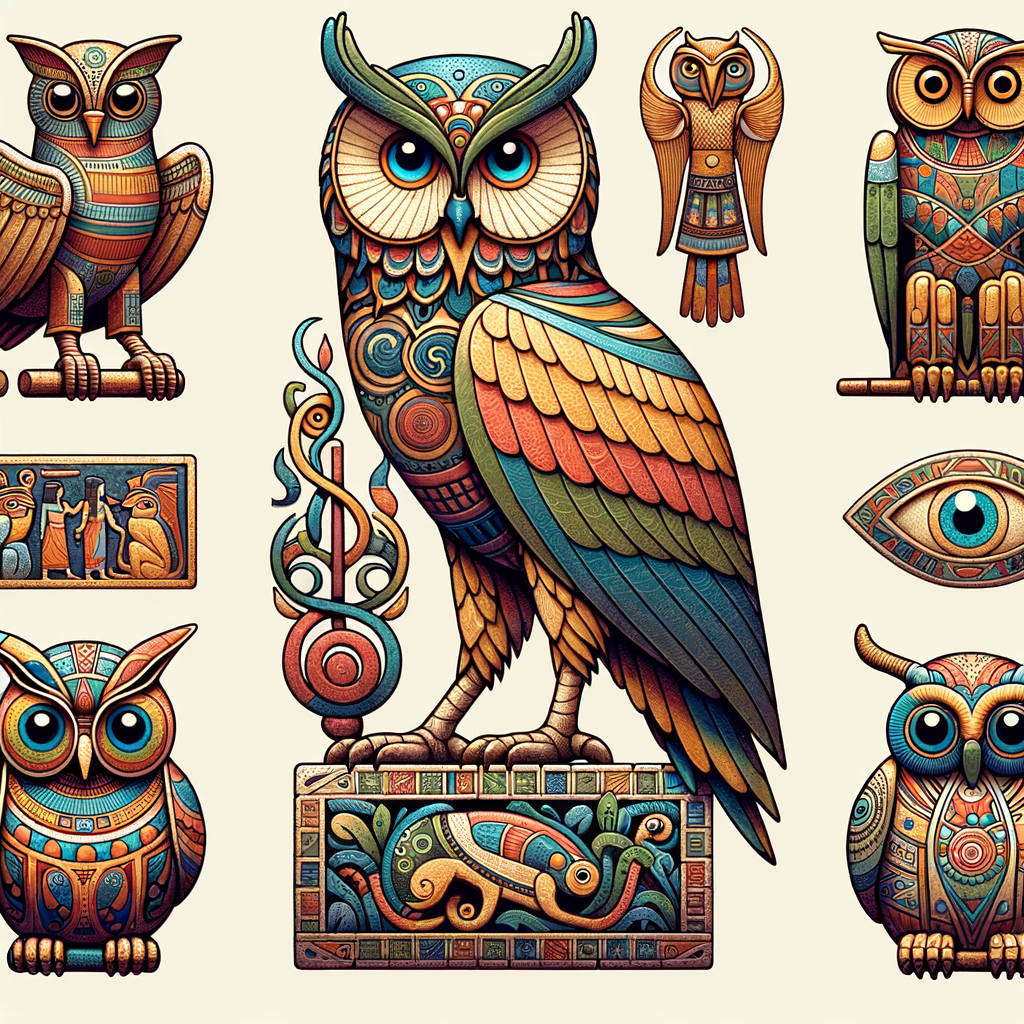
Introduction: Owls in Ancient Civilizations
Owls have fascinated humans for thousands of years. In many ancient civilizations, they were seen as special creatures with deep meanings.
- The symbolic meaning of owls: Owls often symbolize wisdom and knowledge. Many cultures believed that owls had the ability to see what others could not.
- Owls as guardians of the night: Owls are nocturnal, meaning they are active at night. This made people think of them as protectors of the dark and watchers of the night.
- Overview of owls in ancient mythology: Owls appear in many myths and stories. They are often linked to gods and goddesses, and their presence in tales usually carries important messages.
In the sections that follow, we will explore how different ancient civilizations viewed owls. From Egypt to Greece, and Rome to Native American traditions, owls have left a lasting mark on human history.
Owls in Egyptian Culture
Symbolism of Owls in Ancient Egypt
- Owls as symbols of wisdom and knowledge: They were believed to possess great insight and understanding. This belief was so strong that owls were often associated with the goddess of wisdom, Seshat. Seshat was the deity of writing and knowledge, and owls were seen as her sacred animals.
- Owls as omens in Egyptian culture: Many Egyptians believed that owls could bring messages from the spirit world. Sometimes, these messages were seen as warnings. For example, if an owl was heard hooting at night, it might be taken as a sign of impending danger or death. This duality made owls both revered and feared in ancient Egyptian culture.
Owls in Ancient Egyptian Art
- Depictions of owls in hieroglyphics:
They represented the letter “M” in the ancient Egyptian alphabet. These symbols were carved on tombs, temples, and monuments. The owl hieroglyph was detailed, showing the bird’s feathers and large eyes. This attention to detail shows how important owls were in their writing system. - Use of owl imagery in Egyptian architecture:
They appeared in carvings and decorations on buildings. For example, owl images were found on the walls of temples and palaces. These images were not just for decoration; they had symbolic meanings. Owls were believed to protect against evil spirits and bring wisdom to those who lived in or visited these buildings.
Owls in Greek Mythology
The Owl of Athena
- Symbolic meaning of the Owl of AthenaAlso known as the “Glaucus,” is a symbol of wisdom and knowledge. Athena, the Greek goddess of wisdom, chose the owl as her sacred bird. This bird represents clear sight and intelligence. In ancient Greece, seeing an owl was considered a good omen, especially before a battle.
- Depictions of the Owl of Athena in ancient artYou can find it on coins, pottery, and sculptures. One famous example is the silver tetradrachm coin from Athens, which features Athena’s owl on one side. This coin was used around 500 BC. The owl’s image on these items shows its importance in Greek culture.
Owls as Omens in Greek Mythology
-
Interpretations of Owl Sightings in Ancient Greece
In ancient Greece, owls were often seen as omens. People believed that seeing an owl could mean different things. For example, if an owl was seen before a battle, it was thought to bring good luck and victory.
Owls were also linked to the goddess Athena. Because of this, many Greeks saw owls as symbols of wisdom and protection. They believed that an owl’s presence meant Athena was watching over them.
-
Stories and Legends Involving Owls
There are many stories and legends about owls in Greek mythology. One famous story is about the Owl of Athena. This owl was said to sit on Athena’s shoulder and give her advice.
Another legend tells of an owl that helped a hero named Perseus. The owl guided Perseus through a dark forest, helping him find his way.
These stories show how important owls were to the Greeks. They were not just birds but symbols of wisdom and guidance.
Owls in Roman History
Owls and Roman Gods
- The association of owls with Minerva, the Roman goddess of wisdom: Owls were often seen as her sacred birds. The owl symbolized knowledge and was believed to bring wisdom to those who saw it. This connection made owls very special in Roman culture.
- Other Roman gods associated with owls: While Minerva was the main deity linked to owls, other gods also had connections. For example, the god of the underworld, Pluto, was sometimes depicted with an owl. This association was due to the owl’s nocturnal nature and its ability to see in the dark, symbolizing the mysteries of the night and the unknown.
Owls in Roman Folklore
- Common beliefs about owls in ancient Rome:In ancient Rome, owls were often seen as omens. People believed that if an owl hooted, it meant something bad might happen. They thought owls could bring bad luck or even death. For example, it was said that an owl’s hoot foretold the death of Julius Caesar. Romans also believed that owls had special powers and could see things that humans could not.
- Owls in Roman literature and poetry:Owls appear in many Roman stories and poems. The famous poet Ovid wrote about owls in his work, “Metamorphoses.” In this book, he tells the story of a woman who was turned into an owl as a punishment. This story shows how owls were seen as mysterious and magical creatures. Another Roman writer, Pliny the Elder, mentioned owls in his book “Natural History.” He described them as birds of ill omen.
Owls in Native American Traditions
Spiritual Significance of Owls
- Owls as spiritual messengers in Native American cultures: In many Native American tribes, owls are seen as important spiritual beings. They are often believed to be messengers from the spirit world. For example, the Hopi tribe views owls as protectors of sacred knowledge. The Cherokee believe that owls can bring warnings or messages from ancestors.
- Symbolic meanings of different owl species: The Great Horned Owl, for instance, is often seen as a symbol of strength and courage. On the other hand, the Snowy Owl is associated with purity and wisdom. Each owl species has its own unique significance, reflecting the diverse beliefs of Native American tribes.
Owls in Native American Art and Storytelling
- Depictions of owls in Native American art:
Owls have been a significant part of Native American art for centuries. Many tribes, such as the Hopi and Zuni, create intricate owl carvings and paintings. These artworks often show owls with large eyes and detailed feathers. The art is not just beautiful; it also tells stories and holds deep meanings. For example, some tribes believe that owls are guardians of the night. - Owls in Native American oral traditions and folklore:
In some tales, owls are wise creatures that help people find their way. In others, they are seen as messengers from the spirit world. For instance, the Cherokee have a story about an owl that warns a village of an approaching danger. These stories are passed down through generations, keeping the culture and traditions alive.
Conclusion: The Enduring Legacy of Owls in Ancient Civilizations
Owls have fascinated humans for thousands of years. Their silent flight and nocturnal habits have made them symbols of mystery and wisdom in many cultures. Let’s summarize their significance and see how ancient beliefs about owls still influence us today.
-
- Summary of the symbolic and cultural significance of owls:
In ancient Egypt, owls were seen as protectors of the dead. The Greeks linked owls with Athena, the goddess of wisdom. Romans believed owls could predict events. Native Americans saw owls as guardians and messengers. These varied beliefs show how important owls were across different civilizations.
-
- The continued influence of ancient beliefs about owls today:
Even today, owls are symbols of wisdom and knowledge. They appear in books, movies, and art. Many schools use owl mascots to represent intelligence. The ancient views of owls still shape how we see these amazing birds.
| Civilization | Symbolic Significance |
|---|---|
| Egyptian | Protectors of the dead |
| Greek | Wisdom and knowledge |
| Roman | Predictors of events |
| Native American | Guardians and messengers |
Owls have a rich history in ancient civilizations. Their legacy continues to influence our culture and beliefs. These birds remind us of the deep connections between nature and human imagination.






